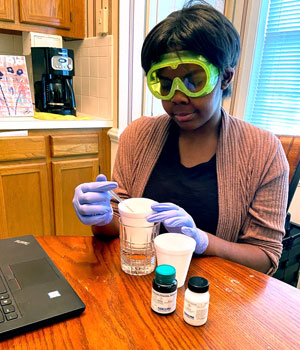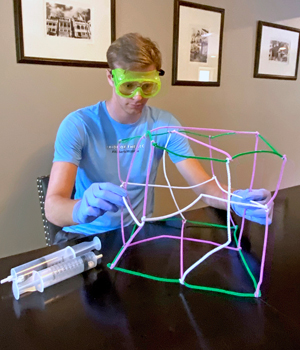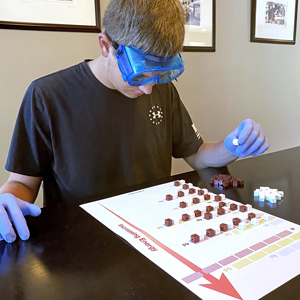My Cart
Your Shopping Cart is currently empty. Use Quick Order or Search to quickly add items to your order!

This is the third in a series of three articles that address remote science teaching and learning. Article 1 lays the groundwork for common terminology adjusted for remote learning and teaching strategies, and article 2 considers methods for effective remote hands-on science learning. This article examines advantages of teaching science standards remotely.
Distance education, while laced with challenges, offers a silver lining for teachers as they evaluate new strategies: teaching remotely to science standards—like the Next Generation Science Standards* (NGSS) and others that are based in phenomena, sensemaking, and hands-on investigations—can keep students engaged and give them an edge that extends learning.
"In some regards, I think that three-dimensional investigation is better done when they [students] are remote," Brett Moulding, a member of the National Academy of Sciences Board on Science Education and of the National Research Council committee that developed the conceptual framework for K–12 science education, says. "This is a wonderful opportunity to change class instruction. . . . It will help teachers understand the pacing of what they’re asking the kids to do and have the kids more interested."
With standards-based, three-dimensional science instruction, students work to figure out the world around them—to make sense of phenomena—by engaging in scientific and engineering practices while applying core ideas and crosscutting concepts. They do this through hands-on investigations or virtual simulated labs when wet labs aren’t safe or possible as they develop models, participate in constructive discourse, and develop artifacts that are evidence of learning and require them to weave together the three dimensions of the standards.

Students are equipped with hands-on materials.

Students are equipped with hands-on materials.
"In some regards, I think that three-dimensional investigation is better done when they [students] are remote."
—Brett Moulding, National Academy of Sciences Board on Science Education
When students are equipped with hands-on materials designed to engage them in three-dimensional learning, such as those in the Carolina Kits 3D® FLEX program, and have access to a platform or strategy that enables them to communicate and collaborate with their teacher and classmates, there are advantages to learning from a remote location.
Since not all student learning locations will be alike, conducting investigations remotely will promote differentiation and support divergent thinking.
Even when students are equipped with the same materials and instructions, not all environmental variables will be the same when students learn remotely. There could be temperature variations, for example, or parents may or may not offer guidance. Hedi Baxter Lauffer, a science education consultant and codirector of the Wisconsin Fast Plants® program at the University of Wisconsin-Madison, says that this lack of teacher control over the independent investigation can actually enrich student learning.
"In a classroom, kids are looking around to see what everybody else is doing and want to conform," she says, noting that working remotely, students will be more focused on their own observations and interpretations. "It’s an opportunity to embrace divergent thinking before we start converging ideas for best explanations. Then we can leverage that for peer-to-peer learning so that when we get together [as a class], the kids . . . are going to be really excited to see each other’s results."
Teachers are more likely to let the students experience their own sensemaking and discovery rather than provide the desired outcome.
"Telling will get reduced down," Moulding says. "It will give kids the space so they can be creative on their own." The teacher can then facilitate a whole-class discussion of the phenomena being investigated, guiding students to discover the critical common understanding. Moulding explains: "The teacher orchestrates the students gathering data, reasoning with it to make knowledge, and then in fact giving them credit for the work, attributing the explanation to one or multiple students."
"The focus of science are the explanations of the causes of phenomena,” Moulding adds. "We know kids that learn this will construct an explanation for a phenomenon that you haven’t shared with them but that they have discovered in the world on their own."
Students don’t have the time constraints of a classroom lab.
"In-school investigations are limited by the length of a class period, but when learning off site, labs can occur over the course of a day or even overnight. "You don’t have to have the kids do the investigation right there in front of you in the hour class time," Moulding says. "Have them plan their investigations and leave them alone. They’ll have the chance to see more things . . . When you come back [for a class meeting], you’ll have a much richer discussion and artifacts to share across the entire class."
As they investigate phenomena, students can apply what they’re learning in the environment where they live.
"They have to be able to apply the phenomenon that they see [in their labs] elsewhere," Moulding says. "They need to revisit these huge, central ideas of the standards repeatedly. The teacher needs to be asking, ‘Where else do you see this? . . . What is the big idea that can be applied to other things, not just this one case?’"
"Extended learning can become a more tangible target that we aim for when we’re teaching students who are learning remotely," Lauffer adds. "We’re always hoping for connected learning that goes beyond the classroom. Now they’ll be conducting investigations where siblings and others can see and wonder too."
Learning among family members may benefit English language learners.
While a quality, three-dimensional lab is student driven and parents don’t need to oversee the work, family members may be more involved because they’re interested in the investigations.
"If we have students growing [Wisconsin] Fast Plants® at home [for a biology investigation], their parents, whether they speak English as their primary language or not, are seeing what’s happening," Lauffer says. "Everyone can get excited and involved about watching those plants grow. . . . Students’ experience of the investigation will go beyond any moments they have on Zoom [video communication app]."

Labs help with sensemaking.
"Extended learning can become a more tangible target that we aim for when we’re teaching students who are learning remotely,"
—Hedi Lauffer, Codirector of the Wisconsin Fast Plants® program at the University of Wisconsin-Madison
Be prepared to teach grades 9–12 science investigations no matter what. The Carolina Kits 3D® FLEX program is a complete NGSS/three-dimensional lab solution that includes digital learning and safe, effective, hands-on lab kits that transition easily between in-class and socially distanced learning. Available for chemistry and biology, each full-year course provides equitable lessons with rigorous, relevant content for consistent results.
To learn more about the program, please complete this form.
*Next Generation Science Standards® is a registered trademark of Achieve/WestEd. Neither Achieve nor the lead states and partners that developed the Next Generation Science Standards were involved in the production of, and do not endorse, these products.